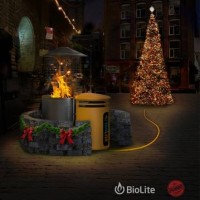Tags: renewable energy
From Scream to Clean Energy

Just under 200 years ago, the modern world began the transition from steam power to electrical power. In 1831, the discovery of an electric current in a wire ignited the second industrial revolution. While people were initially hesitant to experiment with electricity, integrating this new form of power into their lives led to more reliable energy, basic lighting and long-distance communication.
...MOREA Campfire That Can Light up Your Christmas Tree

Imagine warming your hands at a campfire that is also lighting up a Christmas tree in DUMBO.
What’s going on here?
Have you ever felt a regular light bulb after it has been on for a while? It’s hot because a side effect of using electricity is that some of the energy is wasted as heat.
...MOREUncommon Ground: A Freshkills Park Talk

The Arsenal Gallery at Central Park will host Freshkills Park on Wednesday July 10th at 6:00 p.m. as Angelyn Chandler, Capital Program Manager at Freshkills Park, discusses the park’s history and future plans in “Uncommon Ground.” The event is free and part of the Land Art Generator Institute exhibition, please RSVP with artandantiquities@parks.nyc.gov
...MOREThe Undeniable Benefits of Urban Trees
It is inarguable that trees are an integral component of a healthy life. Despite this fact, the case for trees in urban environments needs to be continually proven in order to prevent their elimination. As Atlantic Cities reports, the City of San Diego is setting an excellent precedent by collecting data which demonstrates the overwhelmingly positive mental and physical effects of trees on densely populated environments.
...MORESolar energy as revenue generator at former landfill
A closed landfill in Canton, Massachusetts plans to implement solar power infrastructure that will generate $16.3 million for the city. The landfill sat unused for over 20 years when city officials decided to build a solar array on the site that will include 19,844 solar panels, citing the relatively low investment and significant return.
...MORE‘Light Reeds’ provide current-powered waterfront lighting
A new method for lighting spaces adjacent to urban waterways uses renewable energy powered by water currents. The ‘Light Reeds,’ from New York City-based Pensa, mimic the reeds you might find along creeks or other natural waterways and provide a more ambient light source than harsh street lights.
...MORE2012 LAGI design competition July 1st deadline approaching
‘Renewable energy can be beautiful.’ That is the tagline for the 2012 Land Art Generator Initiative (LAGI) international design competition. The open LAGI competition calls for ideas to “design a site-specific public artwork that also functions as clean energy infrastructure for New York City.”
...MOREMethane generates revenue at Freshkills Park
Methane gas produced from decomposing waste at Fresh Kills landfill is generating revenue for the City of New York of up to $12 million each year as the site is developed into a 2,200-acre park.
With the help of advanced landfill gas collection infrastructure throughout the landfill, the New York City Department of Sanitation is actively harvesting methane, through rigorous state and federal public health and safety guidelines, from the decomposing waste buried at Fresh Kills landfill.
...MORELAGI Field Guide to Renewable Energy Techonologies
The Land Art Generator Initiative (LAGI) team recently announced the release of their Field Guide to Renewable Energy Technologies, a free resource they hope will prove useful to “all designers, homeowners, urban planners, students, artists, architects, landscape architects, engineers, and anyone else interested in a clean energy future”.
Powered by the East River
The Federal Energy Regulatory Commission has approved a 1 megawatt tidal power project on the East River, granting Verdant Power a license to generate and sell electricity from underwater turbines. It is the first commercial license for tidal power ever to be issued in the United States.
2012 Land Art Generator Initiative
Earlier this month, the 2012 Land Art Generator Initiative (LAGI) ideas competition, in partnership with New York City’s Department of Parks & Recreation, opened with a call for large-scale artwork proposals with the ability to generate renewable energy for New York City.
...MORECalifornia landfill to power Marine Corps base
As a part of the US Navy’s initiative to receive 50% of its energy from alternative sources, California’s Miramar Marine Corps Air Station has signed a 15-year power supply agreement with Miramar Landfill, located adjacent to the base. The Navy and the City of San Diego will work in conjunction with New York-based Fortistar Methane Group to harvest enough methane from the landfill–yielding about 3.2 MW–to power approximately 2,461 homes, nearly half of the air station’s energy needs.
...MOREJersey-Atlantic Wind Farm, Atlantic City, NJ
The 7.5 MW Jersey-Atlantic Wind Farm was the first wind power facility built in New Jersey and the first urban coastal wind farm in the United States. It is located within the Atlantic County Utilities Authority (ACUA) Wastewater Treatment Facility site and has been in operation since December 2005.
...MORETwo-in-one solar-wind turbine in prototype stage
Scientists at the University of Liverpool are developing a new wind turbine dubbed the “Heat Waver” that uses solar photovoltaic rotors to generate energy even when the wind isn’t blowing. The team, headed by Dr. Joe King, has built a prototype and is currently determining an installation site on which to test it.
...MOREStudy examines wildlife-friendly biofuel crops
A two-year study at Michigan State University finds that growing native prairie grasses for biofuel harvesting is more beneficial to wildlife populations than monoculture stands of corn. The research team, headed by biologist Bruce Robertson, attempted to identify ecologically sound biofuel alternatives that are as cost-effective as corn, which is currently the primary feedstock for deriving ethanol in the US.
...MORE“Artificial leaves” mimic photosynthesis
Inspired by the natural process of photosynthesis, the Nocera group in the chemistry department at MIT claims to have successfully produced “artificial leaves,” small and inexpensive solar cells that can convert sunlight and water into energy.
...MOREAbout the shape of a poker card but thinner, the device is fashioned from silicon, electronics and catalysts, substances that accelerate chemical reactions that otherwise would not occur, or would run slowly.
Bird safety for wind farm development
According to the American Bird Conservancy (ABC), an estimated 100,000 to 440,000 birds die from collisions from wind turbines in the United States each year, and by 2030 that figure could easily surpass 1 million per year. Although ABC is in support of alternative energy choices such as wind power, they recommend passing regulations for the wind energy industry that take into consideration four measures of avian safety:
1.
...MOREInsight into bird vision could influence turbine design
A new study conducted by Dr. Graham Martin at Birmingham University investigates how bird sight effects collisions with human infrastructure, including wind turbines.
...MORE“When in flight, birds may turn their heads to look down, either with the binocular field or with the lateral part of an eye’s visual field,” says Martin.
Massachusetts landfill to host large solar array
Residents of Canton, Massachusetts have approved plans to install a large solar array on a landfill that was capped and has remained undeveloped since the mid-1980s. The array will consist of 24,000 3′ x 5′ panels that are expected to generate up to 5.6 MW of power by the time the project reaches completion in 2012.
...MOREPrinceton to build largest US university solar field
Next year, Princeton University will begin construction of a 27-acre solar field, hosting16,500 photovoltaic panels, to partially power its New Jersey campus. The array will be built on off-campus university-owned land and is projected to generate 8 million kilowatts of energy per year, or 5.5% of Princeton’s total electricity usage.
...MORE



